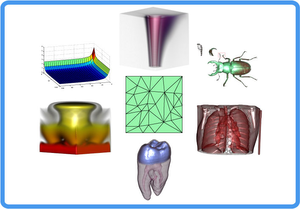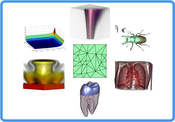Information
- Publication Type: PhD-Thesis
- Workgroup(s)/Project(s):
- Date: November 2009
- Date (Start): 2006
- Date (End): 2009
- Rigorosum: 27. November 2009
- First Supervisor:
Abstract
Technological and research advances in both acquisition and simulation devices provide continuously increasing high-resolution volumetric data that by far exceed today's graphical and display capabilities. Non-uniform representations offer a way of balancing this deluge of data by adaptively measuring (sampling) according to the importance (variance) of the data. Also, in many real-life situations the data are known only on a non-uniform representation.Processing of non-uniform data is a non-trivial task and hence more difficult when compared to processing of regular data. Transforming from non-uniform to uniform representations is a well-accepted paradigm in the signal processing community. In this thesis we advocate such a concept. The main motivation for adopting this paradigm is that most of the techniques and methods related to signal processing, data mining and data exploration are well-defined and stable for Cartesian data, but generally are non-trivial to apply to non-uniform data. Among other things, this will allow us to better exploit the capabilities of modern GPUs.
In non-uniform representations sampling rates can vary drastically even by several orders of magnitude, making the decision on a target resolution a non-trivial trade-off between accuracy and efficiency. In several cases the points are spread non-uniformly with similar density across the volume, while in other cases the points have an enormous variance in distribution. In this thesis we present solutions to both cases. For the first case we suggest computing reconstructions of the same volume in different resolutions based on the level of detail we are interested in. The second case scenario is the main motivation for proposing a multi-resolution scheme, where the scale of reconstruction is decided adaptively based on the number of points in each subregion of the whole volume.
We introduce a novel framework for 3D reconstruction and visualization from non-uniform scalar and vector data. We adopt a variational reconstruction approach. In this method non-uniform point sets are transformed to a uniform representation consisting of B-spline coefficients that are attached to the grid. With these coefficients we can define a C2 continuous function across the whole volume. Several testings were performed in order to analyze and fine-tune our framework. All the testings and the results of this thesis offer a view from a new and different perspective to the visualization and reconstruction from non-uniform point sets.
Additional Files and Images
Weblinks
No further information available.BibTeX
@phdthesis{vucini-2009-phd,
title = "On Visualization and Reconstruction from Non-uniform Point
Sets",
author = "Erald Vucini",
year = "2009",
abstract = "Technological and research advances in both acquisition and
simulation devices provide continuously increasing
high-resolution volumetric data that by far exceed today's
graphical and display capabilities. Non-uniform
representations offer a way of balancing this deluge of data
by adaptively measuring (sampling) according to the
importance (variance) of the data. Also, in many real-life
situations the data are known only on a non-uniform
representation. Processing of non-uniform data is a
non-trivial task and hence more difficult when compared to
processing of regular data. Transforming from non-uniform to
uniform representations is a well-accepted paradigm in the
signal processing community. In this thesis we advocate such
a concept. The main motivation for adopting this paradigm is
that most of the techniques and methods related to signal
processing, data mining and data exploration are
well-defined and stable for Cartesian data, but generally
are non-trivial to apply to non-uniform data. Among other
things, this will allow us to better exploit the
capabilities of modern GPUs. In non-uniform representations
sampling rates can vary drastically even by several orders
of magnitude, making the decision on a target resolution a
non-trivial trade-off between accuracy and efficiency. In
several cases the points are spread non-uniformly with
similar density across the volume, while in other cases the
points have an enormous variance in distribution. In this
thesis we present solutions to both cases. For the first
case we suggest computing reconstructions of the same volume
in different resolutions based on the level of detail we are
interested in. The second case scenario is the main
motivation for proposing a multi-resolution scheme, where
the scale of reconstruction is decided adaptively based on
the number of points in each subregion of the whole volume.
We introduce a novel framework for 3D reconstruction and
visualization from non-uniform scalar and vector data. We
adopt a variational reconstruction approach. In this method
non-uniform point sets are transformed to a uniform
representation consisting of B-spline coefficients that are
attached to the grid. With these coefficients we can define
a C2 continuous function across the whole volume. Several
testings were performed in order to analyze and fine-tune
our framework. All the testings and the results of this
thesis offer a view from a new and different perspective to
the visualization and reconstruction from non-uniform point
sets.",
month = nov,
address = "Favoritenstrasse 9-11/E193-02, A-1040 Vienna, Austria",
school = "Institute of Computer Graphics and Algorithms, Vienna
University of Technology ",
URL = "https://www.cg.tuwien.ac.at/research/publications/2009/vucini-2009-phd/",
}


 thesis
thesis
